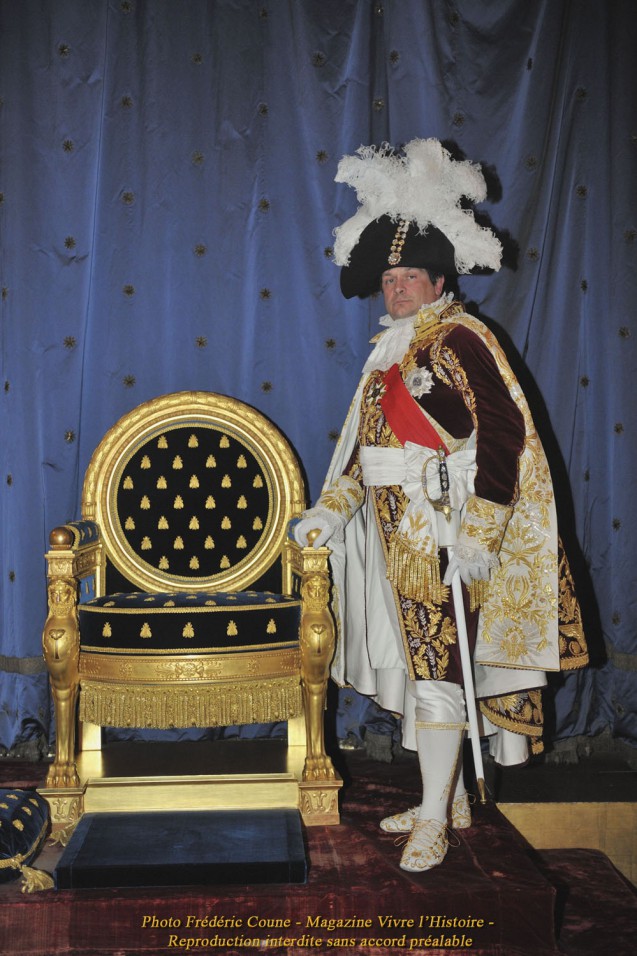For the last ten years you have been the “incarnation” of Napoleon I in the largest re-enactments relating to the First Empire. Where does your passion for this come from?
Frank Samson: My passion both for the First Empire and for reconstitution are linked. I have always been fascinated by history. Originally, I wanted to study history of art and law in order to become an auctioneer. In the end, I became a lawyer, which suits me perfectly. My attraction to history continues however, because I feel that knowledge of history should enable us to live better in the present. Unfortunately, that does not seem to be the case. In my opinion people – especially politicians – are not interested in history and do not learn the lessons of the past, which condemns us to repeat the same mistakes. This is why I often say that “the news” after 1875 does not interest me: I haven’t had a television for 25 years, I do not read newspapers and the political party for which I would like to vote does not exist.
Besides my love of history, I am passionate about “military matters”, especially uniformology and phaleristics [Editor’s note: the study of medals and decorations], I am a “failed” military in some way! All these elements combined naturally led me to be interested in the period of the First Empire, the French heyday notably for military uniforms. And the epic of the Napoleonic adventure is inevitably fascinating: Napoleon or Christ, they are both completely crazy stories!
I am also a “figuriniste” I like to reproduce objects but life-size, in three-dimensions. The problem of a drawing is that it is flat, it does not have the same scientific relationship to the subject. When looking at an object, you can discover things you might not suspect otherwise. The example of the chain of the Legion d’honneur, Type 1 (which no longer exists, all copies were melted down), is striking. Even in a contemporary drawing, the painter Robert Lefebvre made mistakes in drawing the necklace in question: if we follow his drawings precisely, the collar can not be worn. I discovered it by having a copy of the type-one collar made: it is not possible to put it around the neck, because of the overlapping of the double rings. By knowing how much a large marshal fully-embroidered jacket weighs, it is possible to work out whether it could be worn in battle. When you do re-enactments seriously, it is necessary to ask such questions, which in turn enable us to enrich our knowledge about the weight of objects, their volume, how they were used…
My first project was to make facsimiles of uniforms. Then in 2005, the world of re-enactment no longer had an emperor. My predecessor had had to stop for health reasons in 2003. My costume-maker told me this and suggested I go to a reconstitution. The idea of bringing to life one of my uniforms – to see it being worn – appealed to me… But, of my two uniforms, one of an artillery captain in the horse Guards, and the other of the Emperor, it was the latter that fit me, the other being too small! So I went, accompanied by my wife who’d had an Empire dress made for her. Once there, the re-enactors must have decided that I was credible and “co-opted” me as it were! That was ten years ago … Today when I see the pictures of that uniform of 2004, I notice a lot of mistakes! I have made a lot of progress since then and I’ve had the jacket redone five times!
M. Bruchard: How does one embody the Emperor, what are your sources of inspiration? What do you think about especially when you play Napoleon?
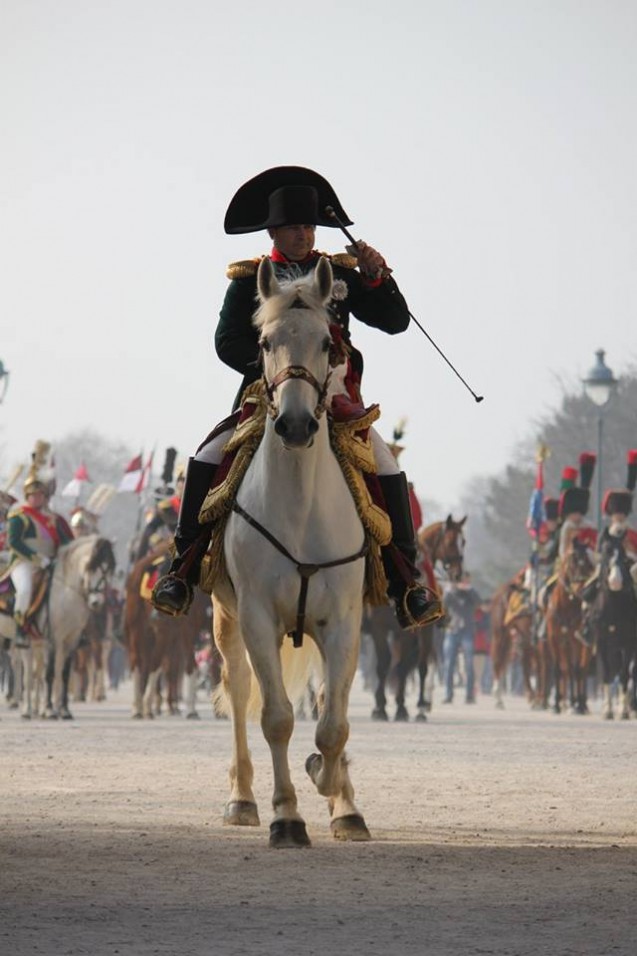
Frank Samson: Frederic Masson’s books were a good starting point for understanding Napoleon, the man. The memoirs of Marchand, Premier valet of the Emperor, (and those of Roustam, Napoleon’s Mameluk) helped me grasp what would have been his character in his daily life. Napoleon was a very nervous person and had tics such as a twitch of the mouth, he also wiped the ink of his feather pens on his white trousers, he broke his watches …. But there are so many details and features of his character! To make a “good emperor,” there has to be a physical resemblance: It is difficult to say that so-and-so is a Napoleon look-alike: we do not really know what he looked like because he never sat for a portrait. We can only extrapolate from a drawing by Girodet which he sat for, and from photographs of his brother Jerome or his nephew Plonplon of whom it was said he was the spitting image of the Emperor … But we can be sure that he wasn’t 1metre 95! Napoleon measured 1m 686 (there are interesting discussions about it because the doctor who took his autopsy spoke of 1m70 but let’s not forget he was measuring a dead body!). My misfortune is that I measure 1m72: I do have a complex about my size (laughs)! However, I am fortunate to have the same eye colour – gray … Moreover, we must have a flawless uniform, because we are scrutinized during the re-enactments. Finally, you need a knowledge of the time: when you make a speech in a bivouac, for example, to say something outrageous would be a lack of respect to the historical person and to history. In a castle near Bordeaux, I participated in the re-enactment of an event in which Napoleon, learning bad news, supposedly broke everything. Well, I broke everything on the table. It was a “tableau vivant”.
M. Bruchard: What advice would you give to an aspiring re-enactor?
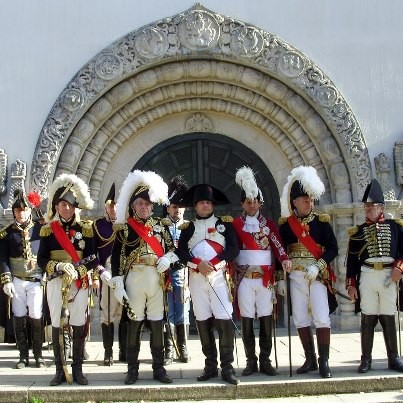
Frank Samson: You have to be rigorous in the realisation of your uniform. You also have to choose the part of the army (artillery, cavalry …) that attracts you. The rest is hard work – it’s not just going camping with friends! Though there certainly is that aspect: when you arrive on a bivouac you see friends again, the atmosphere is friendly, but as I often say: we must do things seriously without taking ourselves seriously. We are only copies, we have to keep our feet on the ground. But when you’re in uniform, you can’t carry your mobile or a plastic water bottle. In order to pay attention to the image that you show to the public, (and the media!) you have to conceal your own personality. But hey, if the media give me trouble at Waterloo, I will have them arrested!
M. Bruchard: On the subject of Waterloo… the re-enactment organised for the bicentenary of the battle will be one of your last appearances [Franck Samson’s final “adieu” will be the re-enactment, in July, on the island of Aix, of Napoleon’s departure to St. Helena]. Is there a rule that emperors have to stop after ten years?
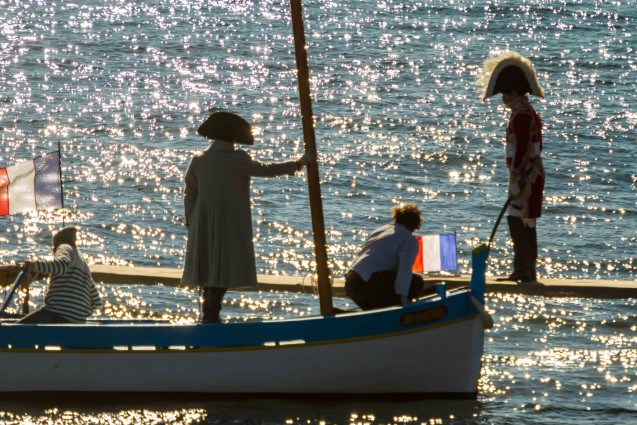
Frank Samson: It’s true my predecessor, Armand Frascuratti, started to play Napoleon Bonaparte around 1992 and stopped in 2003. I’m also stopping after ten years but this is just a coincidence … I do not know if the next “emperor” will do the same. I’m stopping this year for several reasons: I am attracted to conformity (“do the same”, especially as I have the chance to be living it in this bicentennial period) and also I want to move on: this activity is time-consuming for me, for my family (the “Empress” complains a bit …) and we want to move on. Napoleon constructed his “martyrdom” on St Helena with his memoirs. In a way, I’m doing the same, taking my leave while in “full glory” rather than take the risk of becoming the crumbling old Napoleon no-one can stand.
M. Bruchard: What is your best memory of a re-enactment from your entire “career” as Napoleon?
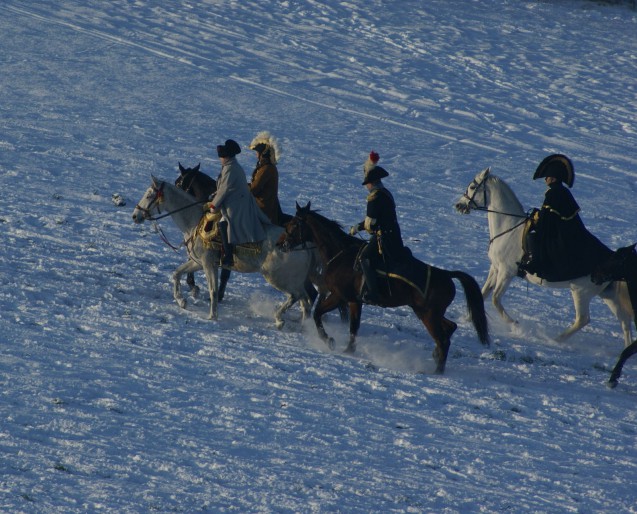
Frank Samson: I have more than one! I would rather speak of images, fleeting moments where you have the feeling that you’re touching the historical moment: maybe Austerlitz, when we returned from the battle, it was -22 °. I was with my hunters on horseback, we were tired … a bit like the picture of the retreat from Russia (by Meissonier). We were riding in the snow, night was falling in the countryside and that’s when I thought, “maybe this is very close to how it was.” The “Sacre” (coronation) was also a memory unlike any other, when it was re-enacted in Boulogne Cathedral. When I met up with my wife, who was playing the Empress, in the carriage before reaching the cathedral, there was an incredible atmosphere! Otherwise, I think of great moments on horseback, galloping, especially at Waterloo, where you get the impression of a living painting, faithful if not quite real, but just the opposite of a “still life”.
M. Bruchard: As a lawyer, do you have a particular view on the Napoleonic Civil Code?
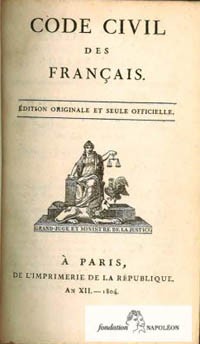
Frank Samson: We live under the Napoleonic era, the construction of our country stems directly from this heritage. There is the Civil Code, and the Criminal Code, but not only. Napoleon was a great legislator. It is fascinating to read the reports of the Conseil d’Etat for the drafting of the Civil Code. Of the hundreds of meetings in question, the Emperor was present at more than half, making very relevant and pointed remarks even though he had never studied Law. Some of these articles are still in use: like Article 2279, “In matters of tangible goods, possession is as good as title deeds”; and Article 212 “spouses owe each other fidelity, help and assistance” (even though it was adapted in 1939). These are beautiful articles. In my professional practice I am a specialist of the Highway Code and the points-system driving licence. The first code relating to this activity dates from 1899, since motor vehicles first became available to the general public, as it were, in 1889. That postdates Napoleon of course, but inevitably, there are Napoleonic implications in any practice of law.
M. Bruchard: At this moment of retirement from your role of Napoleon, do you have new projects? Will you continue to reign over the empire that you founded, that of Lower Chesnaie?
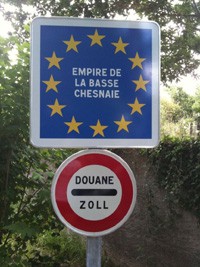
Frank Samson: That is something else that has nothing to do with the world of re-enactments: it is an intellectual game of public law writing. I loved writing my Constitution, decrees and laws. And as I am not a Republican, I chose another form of government, and declared my independence in 1993. We are one of the smallest states in the world with 1.1 hectares. This is a mind game with my friends who are my ministers (I have seventeen) we have fun just as in a game of role-play. It’s a way to reconnect with the magic of childhood and stimulate our imagination on a large scale, always doing this seriously without taking ourselves seriously. The postman knows where to forward the mail that comes for “His Majesty the Emperor”; and our empire is even mentioned on the Wikipedia page of the city of Saint-Thual. I am not about to abdicate from this throne! I have plenty of things to do such as crown my son in my lifetime like the Merovingians, to be sure that our young dynasty is not jeopardised when I’m gone.
June 2015


